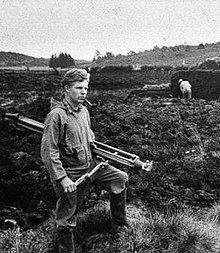| P. V. Glob | |
|---|---|
 Glob in a Danish peat field Glob in a Danish peat field | |
| Born | 20 February 1911 Kalundborg, Denmark |
| Died | 20 July 1985(1985-07-20) (aged 74) Djursland, Denmark |
| Nationality | Danish |
| Alma mater | University of Copenhagen |
| Occupation | Archaeologist |
| Spouse | Harriet Glob (née Roepstorff) |
| Children | Lotte Glob, Anders Glob, Martin Glob, Henriette Glob, Elsebeth Glob |
| Parent | Johannes Glob |
Peter Vilhelm Glob (20 February 1911 – 20 July 1985), also known as P. V. Glob, was a Danish archaeologist.
Glob was most noted for his investigations of Denmark's bog bodies such as the Tollund Man and Grauballe Man, mummified remains of Iron and Bronze Age people found preserved within peat bogs. His anthropological works include The Bog People: Iron Age Man Preserved, Denmark: An Archaeological History from the Stone Age to the Vikings, and Mound People: Danish Bronze-Age Man Preserved.
Biography
Glob was a student of archeology at the University of Copenhagen. He published his dissertation and was awarded his PhD in 1944. He worked for the National Museum of Denmark from 1937 to 1949, then as a professor at Aarhus University from 1949 until 1960, and then as Director General of Museums and Antiquities for the state of Denmark (Riksantikvaren) from 1960 to 1981. He was co-founder of the Scandinavian Institute of Comparative Vandalism, an institution which studied the history of graffiti. His most famous investigation was that of the Tollund Man.
Glob was also heavily engaged in archaeology of the Middle East and led several scientific expeditions there. In the 1950s he discovered and excavated the ruins of the ancient Dilmun civilization on the island country of Bahrain. In 1954 he and his team uncovered the Barbar Temple, considered to be part of the Dilmun culture.
Personal life
Peter Glob was born at Kalundborg on the Danish island of Zealand, the son of the Danish painter Johannes Glob (1882–1955). He later married Harriet Roepstorff and they had five children, including the ceramic artist Lotte Glob. He died at Djursland in 1985.
Select bibliography
- Mosefolket – Jernalderens mennesker bevaret i 2000 år, Gyldendal, 1965
- The Bog People: Iron-Age Man Preserved, translated from the Danish by Rupert Bruce-Mitford. Faber and Faber, 1969, 304 pg. (New York Review Books, 2004).
- Denmark: An Archaeological History from the Stone Age to the Vikings, Cornell University Press, 1971, 351 pg, ISBN 0-8014-0641-2
- Danish Prehistoric Monuments, Faber and Faber, 1971, 351, ISBN 0-571-08782-5
(The two previous book editions derive from the same original book written in Danish: Danske Oltidsminder, best translated as Memorials of Ancient Denmark. See American Anthropologist, Volume 75, Issue 6, page 1940.)
- Mound People: Danish Bronze-Age Man Preserved, Cornell University Press, 1974, 184 pg, ISBN 978-0-8014-0800-7
- Danefæ. Til Hendes Majestaet Dronning Margrethe II, 16 April 1980.
References
- "P.V. Glob". Den Store Danske. Retrieved September 1, 2020.
- Flemming Højlund (1999). Glob og Paradisets have. De danske ekspeditioner til Den Arabiske Golf (in Danish). Moesgård Museum. ISBN 87-87334-32-1. Archived from the original on 24 September 2015. Retrieved 5 October 2014.. Translated to English by Peter Crabb ("Glob and the Garden of Eden") and Arabic by Mohammed Bander ("Ghūlub wa-jannat al-firdaws").
- "The Dane in Bahrain whose findings brought him fame". Copenhagen Post. Retrieved September 1, 2020.
- "Johannes Glob". Dansk Biografisk Leksikon. Retrieved September 1, 2020.
Other sources
- Højlund, Flemming (1999): Glob and the Garden of Eden: the Danish expeditions to the Arabian Gulf (Moesgård Museum, trans. Peter Crabb)
- Bibby, Geoffrey (1969) Looking for Dilmun (Alfred A. Knopf)
- Fischer, Christian (2007) Tollundmanden: gaven til guderne: mosefund fra Danmarks forhistorie (Silkeborg: Silkeborg Museum) ISBN 978-87-7739-966-4
This biographical article about an archaeologist is a stub. You can help Misplaced Pages by expanding it. |
This article about a Danish scientist is a stub. You can help Misplaced Pages by expanding it. |